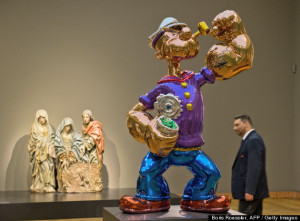The rise of the art advisor tracks the globalization of art business. Art advisors act as a bridge to new classes of collectors, but the role is often not clearly defined. Gallerists, dealers, art fairs and collectors encounter a heterogeneous profession.
This event, held on April 1st, 2015 at Sotheby’s Institute of Art, explores current ethical and business questions that art advising creates and the legal obligations that their relationships rely on. Art Advising 2.0 — Vertigo & Accountability is a collaboration amongst Sotheby’s Institute of Art, the Association of Professional Art Advisors, and Stropheus Art Law.
Moderator: , Chair, Committee on Fine Arts, New York State Bar Association, Entertainment, Arts and Sports Law (EASL) Section, Attorney and Faculty at Sotheby’s Institute of Art
Panelists:
Sean Kelly, Sean Kelly Gallery
, Attorney at Stropheus Art Law
, Executive Director The Armory Show
, Megan Fox Kelly Art Advisory
A dedicated audio recording of Sean Kelly’s comments precedes his text. A video of Richard Lehun’s PowerPoint presentation can be found in the section on his presentation below. Due to a technical malfunction, we regret that a secondary audio source was used for the first eight minutes of the recording.
Judith B. Prowda
Welcome everyone to this evening’s program, Art Advising 2.0. Vertigo and Accountability. I’m Judith Prowda, and I welcome you here this evening to this panel discussion and dialogue. I thank our illustrious panel for participating, and special gratitude to Richard Lehun for planning this panel with me.
Art advising is not a recent phenomenon. The existence of the art advisor dates back at least to the 17th century. Diego Velázquez traveled to Italy in order to acquire works by Titian, Tintoretto and Veronese for King Philip VI of Spain. New and vastly rich industrialists in the 19th century, perhaps more competent in their business acumen than art expertise, also relied on intermediaries, sometimes artists, to cultivate their tastes. Alfred Barnes, for example, depended on William Glackens to educate him and to build his fabled collection. See Georgina Adam, Big Bucks: The Explosion of the Art Market in the 21st Century 93 (Lund Humphries 2015).
In the last century, prominent dealers such as Lord Duveen of Millbank, known in this day as “Napoleon of the art dealers,” guided an impressive roster of clients – Morgan, Frick, Mellon, Altman, Huntington, just to name a few – in forming their prestigious collections. A consummate salesman, Lord Duveen not only ferreted out the most exquisite masterpieces in all of Europe, but he also designed his clients’ homes, consulted with them on their dinner parties, and even kept his vault stocked with their favorite cigars. He was also known to rhapsodize about the paintings his clients acquired long after the deal. As Andrew Mellon remarked, “My pictures never looked so marvelous as when you are here!” See Michael Peppiatt, ‘Duveen’: The Art of the Deal, NYT, Sept. 19, 2004.
There has been a radical shift in the art world in recent years. According to the just released TEFAF report 2015, the global art market topped 51 billion Euros in 2014, an increase of 7% year on year, and its highest recorded level. The sheer magnitude of the global market has made it all but impossible to keep pace. With over 180 major art fairs with an international element, not to mention hundreds of smaller regional and local fairs, plus biennials, triennials and auctions crowding the art world calendar. And this does not include online art sales, which according to the online TEFAF Art Market Report is conservatively estimated to have reached 3.3 billion Euros, or around 6% of worldwide art and antique sales by value. See TEFAF Art Market Report 2015, prepared by Dr. Clare McAndrew. It is a full job simply to navigate the boom. Hence the rise of the art advisor.
Today, art advisors are valued as much for their access to galleries and high quality pieces, as for their advice on what works to acquire. See Mary Rozell, The Art Collector’s Handbook 30-31 (Lund Humphries 2014); Mia Fineman, Art Advisers, NYT Oct. 15, 2006. This is especially so in the primary market, which is largely based on trusted relationships. Top tier galleries with waiting lists for their star artists can be as highly selective as they choose. A trusted advisor can assure a dealer that their prized inventory will be placed in the right collection (the operative word being placed). And that their client will not flip the work either at auction or through another gallery.
At the same time, a well-connected advisor can act as gatekeeper and bridge for dealers to new classes of collectors, who may have money but not necessarily the knowledge of time to build a collection. See Daniel Grant, When Art Buyers Need Help; High-End Purchasers May Have More Money Than Knowledge, WSJ, Feb 2, 2015. For all these reasons, art advisors wield enormous power in the market, and the profession is growing.
There is no professional certification to become an advisor. So reputation is key, as everywhere in the art world. Art advisors practice in different ways. Some dealers are advisors and some banks have specialists who advise their collector clients. The profession is self-regulating.
The Association of Professional Art Advisors (APAA) is the main trade association. Membership is by invitation only. The APAA has its own Code of Ethics. Art advisors who are also dealers are not eligible for membership in the APAA due to potential conflicts of interest.
As in all business relationships in the art world, transparency is key. The best advisors, like the best dealers, desire to establish long-term relationships with their clients, not one-off deals to make a profit.
Who are the art advisors? What qualification does one need to become an art advisor? Who hires art advisors? People who wish to buy for personal enjoyment or to build a serious collection for their future legacy? How does one go about finding the right advisor? And how do advisors work? How are they compensated? Where do they look for art – galleries, art fairs, auctions, online, directly from artists’ studios?
Along with the rise of the art advisor is the emergence of complex legal and ethical issues. For example, and these are but a few: What are the pros and cons of using an art advisor? Shouldn’t people trust their own taste in acquiring art? Is art advising more common in the United States than in other parts of the world? How is art advising understood abroad? How are art advisors paid? Percentage of the purchase price? Retainer? Hourly fee? Isn’t there a potential conflict of interest if an advisor is paid a percentage of the purchase price when they’re negotiating the price on behalf of a collector?
Suppose an advisor has more than one client who wants to purchase a certain artist or a specific work. Who gets it? If an advisor is a dealer, wouldn’t there be a tendency to sell from their own inventory rather than putting their client’s interest first? What about double dipping? That occurs when an art advisor receives a fee both from the collector and from the gallery. Under what circumstances, if any, is this okay, legally and ethically? These are just some of the important questions we will explore this evening.
I’m grateful to my employer, Sotheby’s Institute of Art, for graciously hosting this event, as so many other events I’ve organized in this beautiful space, which is my second home.
This program is part of an initiative to create dialogue amongst lawyers, artists, emerging and established art professionals working in the primary and secondary market. In the past year and a half we have held programs on Gallery Ethics and The Rise of Art Fairs, both in collaboration with the New York State Bar Association Entertainment, Arts and Sports Law Section, of which I am Past Chair.
We have posted an audio podcast and transcript of these programs on the Stropheus Art Law website and will do the same for tonight’s program. Our next event will be on the topic of the online art market.
To explore the complexities on the role of art advisor, let’s begin with the perception of a gallerist, Sean Kelly. We will follow with attorney Richard Lehun, who will explore the nexus between legal and ethical questions. Noah Horowitz will examine how art advising has impacted the global art business and the art fairs in particular. Megan Fox-Kelly will end by exploring legal best practices for art advisors and the role of the Association of Professional Art Advisors.
Thank you very much. Please join me in welcoming Sean Kelly.
Sean Kelly
Good evening and thank you all for joining us this evening. I would like to start out by thanking Sotheby’s Institute, Judith and Richard, for their invitation, and express how happy I am to be on such an illustrious panel with Megan and Noah. I want to point out a couple of facts before I start. This evening is being bracketed by two Kelly’s so it’s going to be good night for them. And we are going to conduct the rest of the meeting downstairs in the bar afterwards.
I have a confession to make, I actually know nothing about this topic whatsoever, and the only reason I’m here is that I got the invitation, I noticed the date was April’s Fool’s Day, and I assumed that it was a joke, so I said “Yes.” Now, I found that it wasn’t, so I’ve done some research. So, I’m going to through some stuff out there just to get us going, and let the experts really attack the topic.
I wanted to pick up on a few things that Judith had mentioned, and there’s one particular theme that I want to illustrate for you more broadly. I don’t want to talk too much about the specifics of art advising or art consulting, I think Megan’s going to talk to that point more fully.
I wanted to start out by picking up from something that Judith said, acknowledging the very important role of artists historically in this field. One of the more maverick and interesting artists of the 20th century, Marcel Duchamp, actually was working as an art consultant and he was the person who brought Brâncuși to America and sold most of the Brâncuși’s in America that you see. Certainly the ones in Philadelphia – the bulk of his own work in that great museum [Philadelphia Museum of Art]. He was also instrumental in the Société Anonyme which ended up becoming the Museum of Modern Art. So, Duchamp’s role as an art advisor, and that of many other artists, has been very important in shaping our culture profoundly.
More recently, those of you who knew Herb and Dorothy Vogel and the incredible collection that they formed, or have the pleasure to be invited to their very small apartment to see their very large collection, were probably regaled with the fact that when they started out, the person who took them around the galleries and introduced them to the artists was Richard Tuttle. So, they too were being guided by an artist.
So, there’s a very long and important tradition that establishes the role of both professional and more informal art advising. The Vogel collection of course ended up going to the National Gallery of Art [in Washington, D.C.].
The historical role of dealers, curators, museums and advisors as taste makers is well-documented and one of the things that struck me when I was thinking about this topic was that when I started working as a gallerist – and I want to make a distinction between being a dealer and a gallerist, but that is not the topic of the evening’s conversation, but I think it’s an important distinction – when I first started working as a gallerist, some 25 years ago, I knew most of the significant players in this field, in my world, having come from being a museum person. And at that point the art world was rather like a country stream. It’s now something more akin to the Rio or the Nile, and it is a raging torrent. And there are now approximately 500, depending on whose advice you take from this, 500 to 800 galleries just in New York City alone. So it’s an enormous amount of professionals selling art, an enormous amount of art students leaving art schools every year, an enormous amount of everything to service that market.
Judith pointed out that the global art market last year is estimated at 51 billion Euros in 2014, there are about 180 art fairs around the world, there are biennials, there are triennials, there are auction houses.
One of the major points I want to make about this – and I will come back around to the art consulting and art advising – is that digital markets are in decline. Last year, the top 10 Hollywood movies grossed $2.5 billion. When you think about that in contrast to the amount of money passing through the art world, it is fairly insignificant. So, Hollywood is in decline, the music business is in decline, why is the art world in ascendency? It’s because we’re an analog business, they’re digital businesses, and we still control our product, to put it bluntly. And most other people can no longer do that in a global market and we are existing in a global market. So we are in a happy position of being in a growing market when many other arts producers and content providers are in a diminishing market. And I think that’s going to be a key issue in talking about these topics as we come back around.
We exist in an increasingly valuable and increasingly complex environment, which is populated by hundreds of thousands of art professionals that simply didn’t exist three decades ago. They weren’t there; they are now. The rise of the professional art advisor and consultant and dealer for that matter – we are all self-regulated – there are no regulations that exist for us outside our own professional organizations, whether it’s the APAA or the Art Dealers Association of America (ADAA) – which I sat on the Board of until recently.
There’s a high degree of moral responsibility because we’re self- regulated, which leads to, amongst our less scrupulous colleagues – and there are less scrupulous colleagues in all walks of life – to potential conflicts of interests. It means that we have to address issues of lack of clarity and transparency in our business. It means we are very reliant upon trust and knowledge and personal relationships, and we’re still in the rather archaic environment of doing business by a handshake and relying on principles and morals when many of our colleagues in all walks of life are heavily regulated.
One could conjecture in that environment – and I’m giving just a very brief view of it – that it would be good to have a road map or a GPS system for an increasingly complex world. I think that one would be encouraged to think about good art advisors, and there are many, as being your GPS system or your road map – or a bridge between the work, your artist, the dealer and your wall.
I’d like to stress that like anything else, there are good and bad art advisors, just as there are good and bad members of every community. Those who work in their client’s best interest are really invaluable, not only to their clients, but to us as gallerists. They are an invaluable link for us in building professionalism in an increasingly plural, complicated and increasingly vast market, frankly.
Part of the reason I was interested in participating on this panel this evening, was to be able to listen to my colleagues talk about and explore the specific role of art advisors, and their responsibilities in light of that world, and in light of the world that we need to navigate in. And of course to really talk with the audience, rather than at the audience, and answer questions from the audience – and at least be able to communicate with the audience – about all of our experiences in dealing with situations that art advisors have been involved in, certainly in the last 25 years that I’ve been a gallerist.
Those are the issues I’d like to raise, and I’d like us to think about as we listen to the rest of the panel and take questions and attempt to answer them for you. Thank you.
 Richard M. Lehun
Richard M. Lehun
My presentation today is going to try to highlight some of the often-misunderstood issues regarding art advising and the status of being an agent. I’m also going to introduce the concept of fiduciary obligations via agency for art advisors.
Many of you may not be that familiar with the concept of fiduciary obligations, but it is a fact that all who are engaged in art advising are actually de facto subject to them, to the extent that you are acting as an agent of a client. This will give us an opportunity to run through some of the considerations that are actually structuring and framing your practice, even if they may be legal, and somewhat removed from everyday understanding.
Agency relationships are at the heart of the art world. Notable examples of agency relationships are in the representation of artists by galleries, the representation of consignors by the auction houses, and the third most prevalent form of agency, which is our topic tonight, the relationship between the art advisor and the buyer.
The single most important thing for art advisors, collectors and gallerists to understand is when advisors are acting as an agent they are legally obligated to be their client’s fiduciaries. Whether it is in a contract or not, whether in contemplation of the parties or not, or no one has raised the issue, the law imposes those obligations. We’ll get into them in a moment to understand more of what that means, but that’s the first take home message. Whether one is aware of them or not, they are simply de facto operative before a court and in law.
Fiduciary obligations order unique and valuable social relationships and are found in many settings where trust is critical. They’re found in doctor/patient relationships, lawyer/client relationships, amongst partners and in corporate governance. Fiduciary duties are imposed by society to balance power differentials. Society has legal structures that anticipate a situation where an advisor has superior knowledge, superior access to information, and may be able to make decisions in their own judgment for a client. A client doesn’t have access to the same type of empowerment, and the law has regimes to increase the security of the dependent party, of the vulnerable party.
Relationships of trust in the art community are inseparable from fiduciary obligations. Now, we have to pause for a moment and think very clearly about what is special about this fact. When fiduciary obligations are active – and they’re active by law – they’re not active by choosing them or not choosing them; they’re simply there. They change the nature of the obligations that people owe to each other in very unexpected and dramatic ways. Instead of being equal parties to a contract, fiduciary obligations create two distinct roles: the fiduciary, that is, the person who has power over another (the art advisor) and the entrustor or principal (the buyer).
It is central to understand that even if you come together under a contract – that is, an agreement that is to benefit each party – when fiduciary duties are present, they can trump any agreement.
I’ve stressed it, but I’ll stress it again, because it’s one of the core factors that gives fiduciary obligations the scope and breadth of their impact – fiduciary obligations are made by judges and courts. By default, fiduciary obligations trump contracts and other non-legal binding agreements. Fiduciary agreements can also be found between an art advisor and client even if both have explicitly disclaimed them. The court may step into a transaction, into a contractual situation, and say the contract between an art advisor and a client is unconscionable, it simply doesn’t have validity because it injures the basic right of a client to certain fundamental and legal norms. It’s important to understand that the courts determine when these fiduciary duties exist and determine their breadth and depth.
As a fiduciary, an art advisor must be loyal – in a moment we’ll get into exactly what that means, but we have to concentrate on the top level concepts first. An art advisor must be free of conflict of interest. Secondly, not only does a law impose this duty of loyalty, it also understands that this duty of loyalty has to be tempered by circumstances, which means that a court can step in and say that an art advisor has not exercised due care. This means that an art advisor has to be prudent in the eyes of the court.
Being prudent means being vigilant – independently vigilant – about conflicts of interest and transparency. Waiting for a client to pose questions is no defense against potential breach of these fiduciary obligations. This is independent of whether a client understands these obligations, is aware of them, demands them, or not. The onus is on the art advisor as the fiduciary to understand these concepts, and legally these rights belong to them even if the client is unaware of them.
Now that we’ve covered briefly the advisor as an agent and fiduciary, let us turn to the devil in the detail. What impact does this have on art advisors in their day-to-day practice?
When an art advisor is in an agency relationship with a client they must represent only that client’s interests. An art advisor cannot pursue any other interest whatsoever by law, and is under a complete obligation to maintain transparency. The client is not obligated to ask for this, or to provide for this, or even to know this. The law imposes this as a default, no matter what an art advisor thinks, has done, or practiced to date. And there is no easy legal argument that can be brought if there is a difficult situation with a client to defend the fact of not having maintained that loyalty.
It’s not a contractual situation, where the advisor can say: “well the client didn’t pay me, therefore I breached confidentiality or I breached conflict of interest provisions.” That’s irrelevant before the law. Because the fiduciary obligations trump whatever contractual issues are at hand, and ignorance is no defense, the advisor is obligated to be professional. The operative assumption by the law is that the client is vulnerable, and it is all but impossible to reverse or change that legal frame.
A key aspect of the fiduciary obligation of an art advisor is the exclusion of third parties and third party interests. The law imposes a fiduciary duty on the art advisor not to do or agree to do anything that would benefit anyone else other than their client. An art advisor cannot generate or intend to generate any profit, any benefit, for anyone but that client without disclosure or agreement on the part of the client.
Excluded third parties that can receive no legal benefit from the actions of an art advisor without full disclosure and agreement on the part of the client include: artists, gallerists, other collectors other clients, other art advisors, museums, framers, art handlers, and other service providers, etc.
The client – again, to stress this important dimension – is not obligated to ask for this, to ask for the exclusion of this. All art advisors are obligated to understand this and practice this by law.
A further deep responsibility of an art advisor as an agent and a fiduciary, is to have no undisclosed profits. In fact, the law mandates that art advisors are obligated to turn over any undisclosed profits. Every undisclosed profit an art advisor makes is automatically owed by law to the client.
Again, the client is not obligated to ask for this, not obligated to enforce this, nor make this an explicit provision of their relationship with the art advisor. If the matter ends up in court, an art advisor’s default fiduciary obligation will force full disclosure and the disgorging of all undisclosed profits.
The exposure to this liability lasts years after the transaction. Therefore, years after a transaction, if for whatever reason a client is not satisfied or has the intuition that there was some conflict of interest or some breach of trust in a transaction, that client can go to a court and force full disclosure of all people connected to a transaction and the disgorging of any undisclosed profits. Even if they were unrelated, and even if the client benefitted.
This is one of the curious things about fiduciary obligations. Even if an art advisor argues, “Well, if I give that hidden advantage to somebody, it will close the deal, my client will be happy, they’ll get the work that they want, but I’m not going to disclose this, because it would reveal to much information, or potentially compromise someone else’s interest.” That is no defense because of the legally imposed obligation of the singular loyalty to the client.
Even if a client agrees to allow an art advisor to generate a benefit for someone other than the client. For example, you (the art advisor) come clean or you actually included a high level of detail in your discussions with your client about how many other people are involved in the deal, what possible benefit that could accrue to them – even there, you don’t necessarily have a defense, because the law imposes an additional burden. You must have acted fairly from the perspective of an independent legal review, regarding the disclosure to the client of the existence of any potential actors who are gaining a benefit, and all other relevant information so the client can make an informed decision.
Even if everything looks great, and everyone is in agreement in the moment, a court can reverse everything and take away any benefit that has accrued to the art advisor and return it to the client, even years after the fact, in cases where the court does not agree with advisor’s and the client’s understanding of fairness. Counter-intuitively, the court may not necessarily take away any benefit received by the client and return it to the art advisor.
Fiduciary obligations take you off the rails of contract. All art advisors are fiduciaries when they’re agents of their clients. This is independent of whether you have a contract or not. So, an art advisor who breaches fiduciary obligations is liable for any unfairness or any lack of transparency, well after the transaction is over.
In closing, I want to note that fiduciary obligations on art advisors are to balance what are called “agency costs.” Agency costs arise when the art advisor or agent takes discretionary but imperfectly observable actions that impact the client.
The fact of operating within the confines of typical art world discretion subjects the art advisor to moral hazards and conflicts of interest, and fiduciary duties are precisely there to address wrongdoing, if it becomes manifest, or if there’s an intuition on the part of a client that it could be present.
In sum, despite not being well-known, fiduciary obligations and the agency relationship are at the core of art advising. In fact, the art advising profession is defined by them, whether art advisors are familiar with this fact or not. The vast increase in the role of art advising means that many people interacting with the profession are doing so without understanding how exposed they are. We hope, with this panel, that we can increase awareness and foster dialogue around this important issue.
I thank you for your attention, and I look forward to your questions later on.
 (0)Dislikes
(0)Dislikes (0)
(0)





